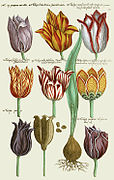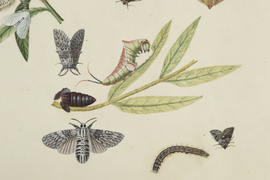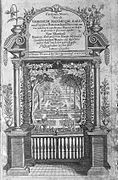Florilegium
Florilegium (plural florilegia , from Latin flos 'flower' and legere '(basis) to collect', for "blossom harvest" or "collection of flowers") denotes:
- in 16./17. Century a kind of representative and documenting catalog of the botanical inventory of a (princely) garden;
- a compilation of text passages ( quotations , idioms , biblical passages ), which are understood as "flower" or "blossom";
- a selection of texts, thus an anthology or “blossom harvest”;
- in music there is also a compilation of motets .
Collection of text passages

This literary form was common in the Middle Ages and the early modern period. It comprised excerpts from the writings of ancient and medieval authors, mostly poets (but also prose writers) or compilations of proverbs, including quotations from the Bible , and often had an encyclopedic character.
They were used in teaching and in writing. As a rule, the verses appealing to the excerptor were written out one after the other from a number of poets . Often the excerpts, which were often changed in text, were arranged alphabetically or systematically. The florilegia provided information about the presence and popularity of the authors. On the other hand, the use of the Florilegia simulated greater literary knowledge in less well-read writers.
Frequent copies with abbreviations, changes and additions make philological research difficult .
Botanical catalogs
Botanical Florilegia deal with flowers and are originally medieval books . They are used for ornate ornamentation rather than medicinal or other useful uses of certain plants or herbs .
The plant reliefs on the walls of the Great Temple of Thutmose III are the first true-to-life depictions of plants and thus forerunners of (scientific) botanical illustrations . in Karnak . Around 400 BC A botanical illustration was created on papyrus (fragment of the "Johnson Papyrus"). The emergence of botanical illustration as a separate art genre originated in the 15th century , when books on herbs were printed with illustrations of flowers describing the culinary uses of plants and, in herbal books (the first illustrated codes), the medicinal uses of plants. It is closely related to the emergence of printing in general. As printing techniques developed and in the 16th century new plants a. A. came to Europe from Ottoman Turkey , wealthy individuals and botanical gardens commissioned artists to capture the beauty of these exotic species in Florilegia.
The ornate printed works had their heyday in the 17th century , when they showed rare and exotic plants. Modern flora and fauna try to document and present plants from certain gardens or places that are now considered endangered .
Due to the effort required to produce them, Florilegia are among the most complex and expensive books.
Page from Volume 2 of the Badminton Florilegium ( Mary Somerset , around 1705 )
Bank's Florilegium: Banksia integrifolia ( watercolor )
Title page of a Florilegium by J. Theodor de Bry
See also
- anthology
- Colored writing
- Chrestomathy
- Katene
- en.wikipedia.org: List of florilegia and botanical codices ("List of florilegia and botanical directories")
- Maria Sibylla Merian
literature
- Benjamin Bühler, Stefan Rieger : The proliferation of plants: A florilegium of knowledge . Frankfurt a. M .: Suhrkamp, 2009
- Gilbert Heß: Forms of Validation in Early Modern Florilegia . In: Owl or Nightingale? Trends and perspectives in cultural studies value research , ed. by Marie Luisa Allemeyer u. a., Wallstein, Göttingen 2007, pp. 73-103
- Florilegia. Genesis, modes of action and transformations of early modern compilation literature. In: Knowledge storage of the early modern times: Forms and functions, ed. by Frank Grunert and Anette Syndikus, Walter de Gruyter, Berlin 2015, pp. 97–138
- Constancy and mobility in early modern florilegia and encyclopedias
- Hanne Kolind Poulsen: The Green Florilegium
- Philipp Otto Roelli: Ascetic writings of the monk Markos (see XIII)
- Loris Sturlese: Philosophical Florilegia in Medieval Germany . In: Ders., Homo divinus: philosophical projects in Germany between Meister Eckhart and Heinrich Seuse , Kohlhammer, Stuttgart 2007, 155–168, ISBN 978-3-17019790-9
Web links
- addisonpublications.com: The transylvania florilegium exhibition
- lecto-historical-editions.com: Bank's Florilegium (English)
- florilegiumsheffield.org.uk: The Florilegium Society at Sheffield Botanical Gardens (English)
- nhm.ac.uk: The Endeavor botanical illustrations (English)
Individual evidence
- ↑ My castle, my carriage - my flowers . In: Städel Blog . December 14, 2017 ( staedelmuseum.de [accessed June 17, 2018]).
- ↑ Benjamin D. Jackson, 1900: A Glossary of Botanical Terms. London: Duckworth & Co., p. 102
- ↑ Wilfried Blunt : The art of botanical illustration. London 1950; 2nd edition ibid 1951, pp. 5-8.
- ↑ Christina Becela-Deller: Ruta graveolens L. A medicinal plant in terms of art and cultural history. (Mathematical and natural scientific dissertation Würzburg 1994) Königshausen & Neumann, Würzburg 1998 (= Würzburg medical-historical research. Volume 65). ISBN 3-8260-1667-X , pp. 142 f.
- ↑ fb-frueheneuzeit.uni-muenchen.de (PDF; 67 kB, 23 June 2018)
- ↑ Archived copy ( memento of the original from October 16, 2013 in the Internet Archive ) Info: The archive link was inserted automatically and has not yet been checked. Please check the original and archive link according to the instructions and then remove this notice. (PDF; 2.6 MB, Prestel , Munich and others, June 23, 2018)
- ↑ zora.uzh.ch/ (PDF, 5.6 MB, introduction, first edition and translation of a Florilegium and three sermons. University of Zurich , Art Faculty, 2009, MB, June 23, 2018)






